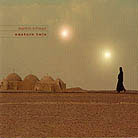November 2000
If you think of ambient groove this way, its appeal is easy to understand. Stravinsky caused riot and mayhem when his pivotal Paris premiere of "Le sacre de printemps" announced that the hegemony of melody and harmony over rhythm was entirely arbitrary and about to be ransacked. Popular styles like rap, dancehall and house have continued Stravinsky’s original assault on Western melodic culture. They have nearly completely stripped music of its melodic and harmonic context to focus instead on increasingly complex rhythmic grooves that seem to bypass the frontal brain and go straight to the much older, more primitive part that’s active during dreams, trances and visions. Many westerners crave any opportunity to reconnect with the deeper layers of our being. Ambient music seems to offer just that. Martin Tillman is a classically trained cellist who has previously released an unabashedly romantic, purely acoustic new age outing on the Hearts of Space label in collaboration with Michael Hoppé and Tim Wheater. Eastern Twin is a fascinating world-beat ambient album that craftily combines acoustic and electric elements and follows in the footsteps of genre leaders Jamshied Sharifi’s The Soul of Layla (Alula) and the twin Tulku collaborations on the Triloka label. Just as salt intensifies flavors, punching up contrast settings but otherwise blending into the background, so does Tillman’s acoustic and electric cello provide melodic fragments and effects. But, again like expertly administered salt, he never overpowers or claims center-stage. Of course, Tillman, together with Tom Vedvik -- keyboards, programming and sampling -- is the album’s intellectual author, but he allows his own importance to disappear in the work, which is shared among all the musicians equally. Authorship could almost as easily have been credited to one of the other performers. Eastern Twin is mood music that creates an aural context in which the listener is invited to free-associate and conjure up flickering images and inner journeys. As suggested by the Moroccan desert village cover-art, not to mention the song titles such as "Trans Mojave," "Amadeus on the Nile" and "Odessa," those journeys will probably roam widely. One track explores the consonant tension between the fundamental and its raised seventh, which is very much an Indian Raga tradition. "Rue Sibelius" does away with the sampling-percussion derived rhythmic weave entirely and is an all-cello string quartet that uses the instrument’s lower registers con arco with intense sawing to evoke a mood as thick and heavy as Shaman’s smoke. "Take me down after midnight, into the fields of color when nothing’s on my mind"’ is a coolly delivered, white-noise -- injected brief vocal from the track "Nothing on my mind" -- one of only two works with lyrics. (Tribal-type chanting of unrecognizable origin does appear elsewhere.) But these words are sufficient to suggest the same kind of minimalist Zen poetry that the music conveys so powerfully on its own terms already. To appreciate the care that Martin Tillman has taken with this album, one must pay attention to the subtle details that make possible the palpably organic gestalt of this music. But that’s like concentrating on the play of light upon the water. Because it’s constantly changing, it evades fixed examination. Eastern Twin combines diverse elements from trip-hop, ambient groove and world beat into a stimulating new hybrid that works the lighter strata of the same mine that deep-ambient magicians like Roach excavate. It’s simultaneously minimalist and rich in detail, and it withstands repeated scrutiny. Fans of the genre take note: This one belongs in your collection. Take it along with you on an endless road trip -- as I just did -- and program repeat. It’ll make you feel like an ancient traveler passing through vistas of jungles, deserts and moon craters, even if all you’re traversing is the block outside your home. GO BACK TO: |
 Martin Tillman - Eastern Twin
Martin Tillman - Eastern Twin![[Reviewed on CD]](../format/regcd.gif) Sitting
by the ocean looking out over the waves can be hypnotic. Light reflections create
ever-changing patterns, wind shifts cause interference ripples, and occasionally some
flotsam or debris rides the swells or whitecaps to capture one’s attention. But
it’s the essential surface repetitiousness of perpetual motion atop the fathomless
deep of the seas that causes our eternal fascination and concomitant slightly altered
states of consciousness during wave watching.
Sitting
by the ocean looking out over the waves can be hypnotic. Light reflections create
ever-changing patterns, wind shifts cause interference ripples, and occasionally some
flotsam or debris rides the swells or whitecaps to capture one’s attention. But
it’s the essential surface repetitiousness of perpetual motion atop the fathomless
deep of the seas that causes our eternal fascination and concomitant slightly altered
states of consciousness during wave watching.